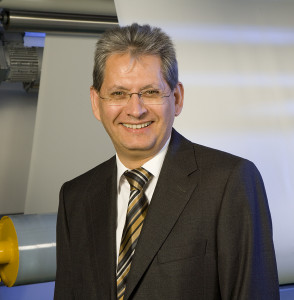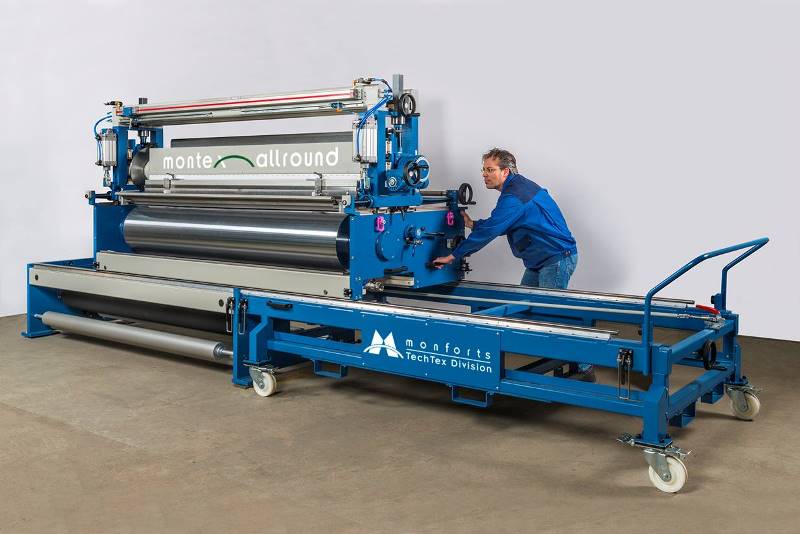The classic phrase “mass production” hardly has any meaning for technical textiles any more. As systems are constantly having to be adjusted and adapted to meet various requirements, exceptional flexibility and sophisticated design engineering principles are needed. A. Monforts Textilmaschinen GmbH & Co. KG responds to these new market requirements with an efficiency-enhancing innovation. Its modular coating system is the only one of its kind in the world.
Technology Head Peter Tolksdorf answered questions about it:
Excerpts:

Innovation cycles for textile machines are relatively long. But you succeeded in developing and bringing the “Montex-Allround” to market quite quickly.
That is unusual, because it often takes years to get from the idea to market approval. Everything happened faster with the “Montex-Allround” modular coating unit. The idea was born in 2012, the prototype was unveiled in Asia in 2014, and the machine itself will make its European début at the Techtextil trade fair in Frankfurt at the beginning of May. One machine has already been sold to a customer in Bangladesh; customer interest in being able to coat technical textiles with maximum flexibility is enormous.
The innovation behind it?
It is based on intelligent automation and is of completely new design. There is no modular system like it on the market. Our unit is an integral component of the stenter frame. The remarkable thing about it is its two-part construction with a permanently installed lower section and a modular upper section, which can be replaced very quickly according to the intended application. At the same time, the modules i.g., for knife and slot die coating and for rotary screen printing are variable. This means that machines with this equipment are extraordinarily versatile. Entire modules can be swapped out in a few minutes. The stenter frame is back in operation after a very short tooling time. Another bonus for effectiveness comes from the fact that the time-consuming cleaning of modules can be performed outside of the stenter frame.
The operational advantages are impressive, but does the customer not perhaps have to change his customary ordering methods?
Previously, the user had do decide on a quite specific coating system when making the investment decision. Application Y could be bought for price X. But that is history now. With “Montex-Allround”, he only needs to decide on a stenter frame, and with this he buys the option to choose from the modules that are required in each case. Moreover, the system is constantly being developed further. Subsequent upgrading with special modules can be arranged without difficulty.

What does this mean for the machine philosophy of the future?
Requirement profiles are changing constantly for technical textiles, and increasingly for traditional textiles as well. So flexibility is of the essence. In the systems of the future, the automation process must be designed in such a way that as many parameters as possible can be processed with a single equipment configuration and rapid retooling options. Our Montex Allround makes that possible. It is all the same whether a coating has to be applied to fire brigade uniforms or medical filters: where two systems were needed before. Now and in future the job can be done with one. Monforts has always shown in the past, as with the Montex Twin Air System, or now with the Montex-Allround, that such developments lead the world. That should and will not change.
Let us talk about energy conservation in Monforts equipment
Redesigned modules are being offered with this in mind as well, capable of lowering the costs of energy-consuming equipment for woven and knitted goods as well as non-wovens. With integrated heat recovery systems, exhaust air is used to preheat fresh air, and energy savings as high as 35 per cent can be realised with these. For machines that are not yet equipped with an integrated heat recovery system, we offer the “Energy-Tower”. It can be retrofitted on the side and achieves similar results.
What do the customers say?
Quite apart from the environmental benefit, they are often surprised by how quickly their investment pays for itself.
Monforts supports the VDMA “Blue Competence” initiative – with what result so far?
Monforts is proud to display the “Blue Competence” label. It is proof that the package of measures stipulated by VDMA with a view to energy conservation and production efficiency, have been implemented voluntarily in our new developments and tested in-house. Since we have just been talking about heat recovery: the ECO Booster HRC is the latest development for Monforts systems, and conforms to both of these requirements. During the production process, a computer-controlled thermal wheel optimises the heat exchanger output with respect to the flow of exhaust air at any given moment. This increases efficiency. At the same time, a cleaning device for the thermal wheel, also automatic, ensures that the system is always operated with the highest level of efficiency. This cleaning process takes place without interrupting production.
Mönchengladbach design engineers have also undertaken a thorough examination of energy-intensive textile drying methods…
You are referring to the Eco Applicator which is capable of saving up to 60% of the heating energy in the drying process during single or double-sided coating of textiles. The denim industry (jeans material) in particular recognised the potential of this, and has already invested in the technology. Interest in this pioneering new development is very high worldwide. The most important point for the success of this device is that the initial moisture must be reduced before drying. Logically, if the goods contain less moisture, less heat energy is required to evaporate the water. This is where the sustainability concept is implemented. This unit applies a minimum quantity of liquor to the product. The substrate is not immersed in a liquid as is usually the case. Instead, the finishing liquid is applied as a thin layer by the application rollers in defined quantities. In this way, the required application quantity can be calculated precisely beforehand, so less liquor residues are left and the waste water total is improved.
“At Monforts no new development is begun without a simultaneous ecological impact evaluation, particularly with regard to energy conservation.”
– Mr. Peter Tolksdorf, Head of Technology, Monforts Textilmaschinen GmbH & Co. KG